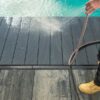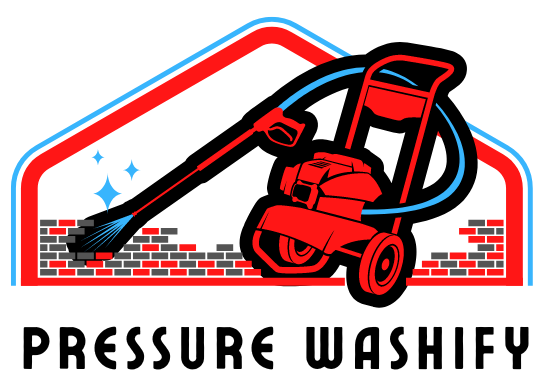Affiliate Disclaimer: This post may contain affiliate links, meaning we get a commission if you decide to make a purchase through our links, at no extra cost to you.
SH (Sodium Hypochlorite) is a strong chemical that will make your cleaning activities a breeze! This amazing product has the capacity to transform even the dirtiest surfaces, leaving them flawless and new-looking.
But what is SH in pressure washing, and how does it unleash its full potential in the pressure washing industry? Where can you get this amazing cleaning chemical, and what’s the trick to getting the perfect mix? How can you use its power to produce the best cleaning results?
If these questions grabbed your interest, you’ve come to the perfect place!

The Role of SH (Sodium Hypochlorite) in Pressure Washing
What is Sodium Hypochlorite (SH)?
SH (Sodium Hypochlorite), also known as bleach is a highly effective cleaning and disinfectant. It’s a sodium, chlorine, and oxygen chemical that’s widely employed in a variety of industries, including water treatment, sanitation, and, of course, pressure washing.
You may even recognize it as the major component in home bleach!
Did You Know?
Sodium hypochlorite (NaOCl), most commonly known as household bleach, was first produced in 1789 by the French chemist Claude Louis Berthollet in his laboratory in Paris. Interestingly, aside from its widespread use as a disinfectant, it’s also instrumental in purifying drinking water, making it safer for millions of people worldwide.
How SH is used in Pressure Washing
SH is often used with water and sometimes additional cleaning agents to make a powerful cleaning solution in the context of pressure washing.
This solution is then applied to the surface being cleaned using a pressure washer, which sprays the mixture at a high pressure to break down and remove dirt, grime, mold, and other contaminants.
The Advantages of Using SH in Pressure Washing
The use of SH in pressure washing improves the cleaning process greatly because it not only helps to break down persistent stains and contaminants, but also kills mold, mildew, and algae.
This is particularly important when cleaning exterior surfaces, where these unwanted substances can thrive and cause potential health risks or structural damage if left untreated.
Effective Mold, Mildew, and Algae Removal
One of the main reasons SH is used in pressure washing is its amazing ability to remove mold, mildew, and algae. Mold and algae-covered bricks can be effectively cleaned using a soft wash method with the appropriate detergent.
These unwanted substances are not only ugly, but they can also pose health hazards and cause surface damage over time.

Eco-friendly Option
While SH is a chemical component, when used properly in pressure washing, it is considered an eco-friendly solution, pivotal in the soft wash process. This is because it breaks down into salt and water after reacting with organic materials, making it safe for the environment when used in appropriate concentrations.
Furthermore, utilizing SH in your pressure washing solution can reduce the quantity of water required to clean a surface because it helps to break down contaminants more effectively than water alone.
Better Cleaning Results
The addition of SH to your pressure washing solution can improve overall cleaning performance significantly. It helps to break down tough stains, filth, and grime, making it easier for the high-pressure water spray to remove them from the surface.
The final result is a cleaner, brighter, and more appealing exterior that will make you proud!

Kills the Coronavirus!
To protect ourselves and our loved ones from the unique coronavirus, it is critical to maintain a clean and sterilized atmosphere in these unprecedented times.
SH has been shown to be an effective disinfectant against a variety of viruses and bacteria, including the coronavirus.
It may assist to keep surfaces clean and clear of dangerous germs when used correctly and in the optimum doses.
Precautions to Take When Using SH in Pressure Washing
While SH is a highly effective and environmentally friendly cleaning solution, it is critical to use it safely and take the required steps to protect yourself, your property, and the environment.

Wear the necessary safety equipment.
It is critical to use appropriate protective gear when dealing with SH to avoid skin irritation, eye damage, and respiratory difficulties.
Wearing gloves, goggles, a mask, and long sleeves help to reduce direct contact with the cleaning solution. Always remember that safety comes first!
Read the SDS sheet
Before using SH in your pressure washing solution, make sure you read and understand the manufacturer’s Safety Data Sheet (SDS).
This document offers critical information regarding the product’s correct handling, storage, and disposal, as well as potential risks and first-aid procedures.
Follow Proper Mixing and Application Guidelines
It is critical to follow the prescribed mixing ratios and application directions while using SH in pressure washing. This may differ based on the product, so consult the label or manufacturer’s instructions.
Using the proper concentration of SH will ensure that the cleaning solution is both effective and environmentally safe for every job.
Be Mindful of Surrounding Plants and Animals
While SH is generally considered eco-friendly, it can nonetheless be hazardous to plants and animals if not used carefully.
To avoid any harm, make sure to rinse off any nearby plants or vegetation before and after pressure washing, and keep dogs and wildlife away from the area while cleaning.
Alternatives to SH in Pressure Washing
While SH is a popular and effective choice for pressure washing, it’s always a good idea to be aware of other options on the market.
Vinegar
Vinegar is a versatile and environmentally safe cleaning ingredient that can be used for light cleaning jobs in pressure washing. It is especially effective at removing dirt, grime, and mineral deposits from surfaces.
Simply mix equal amounts of white vinegar and water and apply it to the surface with a pressure washer to utilize vinegar in pressure washing.
Remember that vinegar may be less effective than SH at removing mold, mildew, and algae.
Oxygen Bleach
Another option for SH in pressure washing is oxygen bleach, often known as sodium percarbonate. It is a non-toxic, biodegradable cleaning solution that effectively removes filth, grime, and stains from surfaces while being gentle on the environment.
To use oxygen bleach in pressure washing, mix the powder with water according to the manufacturer’s directions before applying the solution with a pressure washer.
Eco-friendly Commercial Cleaners
There are also a number of environmentally friendly commercial cleansers on the market like the Simple Green Oxy Solve Total Outdoor Pressure Washer Cleaner that can be used as alternatives to SH in pressure washing.
These products are specifically developed to be environmentally friendly while also giving effective cleaning results.
Where to Buy SH for Pressure Washing
Finding the ideal SH product for your pressure washing needs is essential for getting the greatest cleaning results. With so many options on the market, it might be difficult to select the best product.
Where to Buy SH Products
SH for pressure washing is available in a variety of sites, including:
- Hardware stores in your area: Many local hardware or pool supply stores sell SH in their cleaning goods area. This option allows you to see the product in person and consult with store personnel if you have any questions or concerns.
- Centers for home improvement: Large home improvements stores, such as Home Depot or Lowe’s, frequently stock SH for pressure washing. You can find the product you need by visiting their stores or browsing their websites.
- Online merchants: SH items from many companies are available on online buying platforms such as Amazon. This option allows you to compare multiple options, read user reviews, and have the product delivered right to your door with free shipping.
Our Recommendation
To make your search easier, we studied and discovered a great SH product on Amazon. The Alliance Chemical Sodium Hypochlorite 12.5% is our top pick.
We have tested it with a pressure washer and found it to be extremely effective in cleaning mold and algae.
It is the strongest bleach available to the public and has the following advantages:
- Simple to use: To make a powerful cleaning solution for pressure washing, simply mix the liquid with water according to the manufacturer’s instructions.
- Versatile: It is appropriate for a variety of surfaces, including concrete, wood, and vinyl siding.
- Eco-friendly: The product is environmentally benign, causing minimal harm to plants and wildlife when used appropriately.
How to Prepare and Mix SH Solution for Pressure Washing
Simply follow these steps to create a good mix of Sodium Hypochlorite solution. This solution can tackle even the most difficult cleaning tasks in no time, perfect for power washing your driveway!
- First and foremost, safety: Before we begin, make sure you’re wearing proper protective gear, including gloves, goggles, and long sleeves because SH is a powerful and possibly toxic chemical.
- Gather your materials: To mix your solution, you’ll need a clean, empty container (ideally with a cover), a measuring cup, and fresh water.
- Examine the concentration: Look at the label on your SH bottle to determine the product’s concentration. This data is critical for calculating the best dilution ratio for your cleaning requirements. Typically a strength of 12.5% is used in cleaning industry.
- Calculate the dilution ratio: You’ll need to dilute your SH depending on the surface you’re cleaning and the level of filth. For pressure washing, a common SH to water dilution ratio is 1:10 (one component SH to ten parts water). However, depending on your specific needs, you may need to change this ratio.
- Mix and measure: Pour the proper amount of SH into the container after carefully measuring it using the measuring cup. Then, according to the dilution ratio you computed, add the needed amount of water to the container.
- Gently stir: To thoroughly blend the SH and water, use a long-handled stirrer or spoon to gently mix them. Remember to mix carefully to avoid spraying the solution on yourself or nearby surfaces.
- Label your container as follows: To be safe and avoid unintentional abuse, label your container with the dilution ratio and a notice about the contents.
Mixing SH Solution
To prepare a sodium hypochlorite (SH) solution for pressure washing, examine the concentration on the label (typically 12.5%), and calculate the dilution ratio, commonly 1:10 SH to water for general cleaning. Measure and mix the SH with water gently, adjusting the ratio as needed for specific cleaning tasks.
You can also watch this excellent video by “Forever Self Employed” to learn easy way to mix bleach for pressure washing.
Correct Way to Apply
Here are the steps to apply sodium hypochlorite with a pressure washer, ensuring that your surfaces are not only clean but also disinfected.
Step 1: Fill the Pressure Washer Tank
Take your prepared sodium hypochlorite solution and fill the tank of your pressure washer. Make sure that your pressure washer is turned off and completely cool before filling it to prevent any accidents.
Some models may require you to use a downstream injector or a separate sprayer to apply chemicals, so check your manufacturer’s instructions.
Step 2: Wet the Surface
Before applying the disinfectant, wet the surface to be cleaned with a low-pressure spray. This prepares the surface by removing loose dirt and debris, allowing the disinfectant to get direct contact with the areas where it’s most needed.
Step 3: Apply Sodium Hypochlorite
Using the pressure washer, apply the SH solution using low pressure so the disinfectant doesn’t aerosolize and to ensure the safety of the person applying it. Cover the surface evenly, taking care to spray from a distance that allows the product to reach all necessary areas without causing any damage.
Step 4: Allow Dwell Time
After application, allow the sodium hypochlorite solution to dwell on the surface for the recommended time. Dwell time is crucial as it gives the disinfectant enough time to break down the stubborn stains and kill any pathogens present.
The appropriate dwell time varies based on the concentration of the solution and the type of surface, so refer to the guidelines for your specific cleaner.
Step 5: Rinse the Surface
Once the dwell time is over, thoroughly rinse off the sodium hypochlorite solution with clean water using your pressure washer. Ensure all traces of the disinfectant are gone, as residual chemicals can be harmful if left to dry on the surface.
Step 6: Let It Dry
After rinsing, allow the surface to let it dry completely. This step is essential, especially for areas where slip hazards could occur, or where a slick surface would be undesirable. It also ensures that the disinfectant has completed its job before any contact.
How to Care for Your Pressure Washer After Using SH

Proper maintenance promotes effective cleaning and extends the life of your pressure washer.
- After each usage, clean the nozzles and attachments: Cleaning nozzles and attachments of dirt, grime, and debris minimizes clogs and ensures constant performance throughout cleaning activities.
- To avoid residue buildup, flush the system with clean water as follows: Flushing helps preserve the internal components of the pressure washer from potential damage caused by cleaning solution residues, especially when using SH or other chemical agents.
- Regularly inspect and replace hoses and seals: Checking hoses and seals for wear, damage, or leaks is essential after every use. Early repairs enhance the life of your pressure washer.
- Keep the pressure washer in a cool, dry location: Proper storage protects the unit from damage caused by exposure to the weather and keeps it ready to use whenever it is required.
- SH solution should be kept in a cool, dry location: To keep the efficacy of your SH solution, remember to store it in a cool, shaded area. Proper storage ensures that your cleaning chemical performs optimally and has a longer shelf life.
Final Thoughts
Now that we’ve addressed the question, “What is SH in pressure washing?” it’s time to put its incredible cleaning power to the test. With the information in this blog, you’ll be able to tackle your next pressure-washing assignment like an expert.
Don’t be afraid to test SH and see how it can actually transform your cleaning routine. You’ll wonder how you ever got by without it!
Frequently Asked Questions (FAQs)
1. What is Sodium Hypochlorite and why is it used in pressure washing?
Sodium hypochlorite is a powerful cleaning agent often used in pressure washing. It is capable of removing even the toughest stains.
2. Is it safe to use Sodium Hypochlorite for pressure washing?
Yes, it’s safe, but it’s mandatory to take safety precautions when using this chemical, such as wearing eye protection and appropriately storing it.
3. What’s the typical mixing ratio for Sodium Hypochlorite in pressure washing?
Typically, for house washing, a mix of Sodium Hypochlorite (SH), water, and a surfactant is used. The mix strength can vary for each job. A common mix ratio might be 2 gallons of SH, 3 gallons of water, with 1 ounce per gallon of the surfactant.
4. What strength of Sodium Hypochlorite is typically used in the cleaning industry?
In the cleaning industry, Sodium Hypochlorite commonly comes in varying strengths, the most common of which are store-bought at 6%, and industrial strength at 12.5%. The strength often used in the cleaning industry is 12.5% Sodium Hypochlorite.
5. How should Sodium Hypochlorite be stored when not in use?
Sodium Hypochlorite should always be stored in a cool, dry place away from direct sunlight and combustible materials like gas. It should be kept in a tightly sealed plastic container, clearly labeled, and away from children and pets.
6. Is Sodium Hypochlorite harmful to plants and vegetation?
Sodium Hypochlorite can be harmful to plants and vegetation if they are exposed to concentrated amounts. Therefore, it is recommended to carefully use it in areas with plants or vegetation, ensuring that plants are properly rinsed with water before and after the pressure washing process to dilute any residue.











